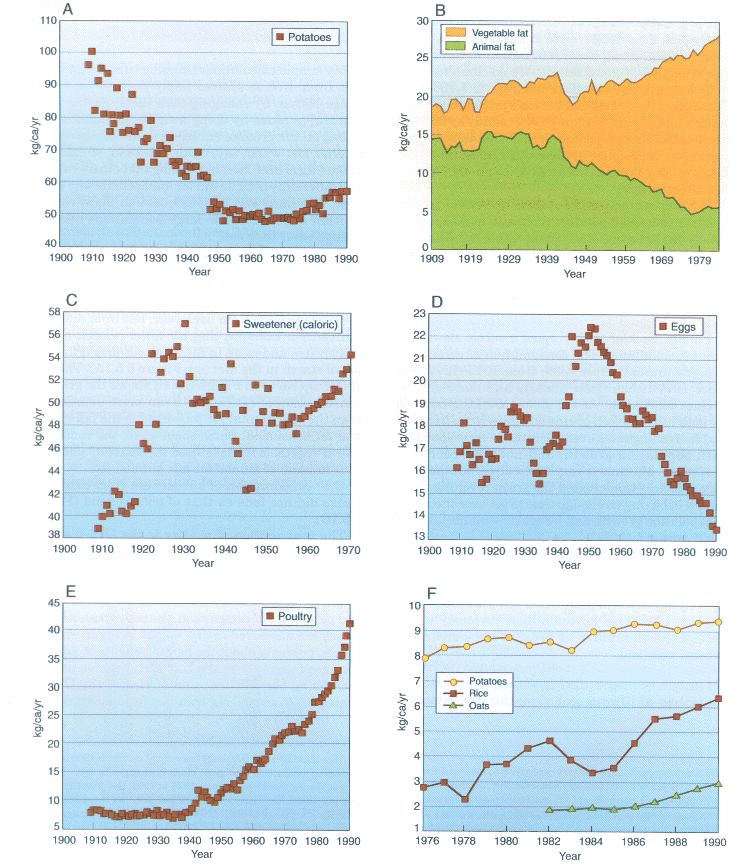My simple calculations lumping calories and protein from diverse sources imply that people would oblige Nature by changing their diets. Saving agricultural produce by doing away with animals and eating all the produce ourselves easily conserves the calories lost when, say, cattle eat 13 kg of maize to make 1 kg of beef. Recommending that others eat less and differently is facile fun for intellectuals who know best. The hard and serious question, however, is, ``Within a few years, do large populations actually change what they eat?".
In the United States, millions do. Since 1909, the
USDA (various years)[USDa]![]() has estimated annually what
millions eat. During these eight decades, U.S. residents
have consumed more or less the same amount
of calories and protein each year, but from different
sources. For example, they ate fewer calories in carbohydrates
and more in fat. Potatoes dramatize the
fall of starch in the diet (see Figure 5.5. 1A). The rise
of the top curve in Figure 5.5. 1B shows the growing
consumption of fat/capita. Even more astounding
than the rise in total fat consumed is the fall in animal
fat consumed. Since about 1940, the consumption
of vegetable fat
has raised the total fat, while the
consumption of animal fat has plummeted.
has estimated annually what
millions eat. During these eight decades, U.S. residents
have consumed more or less the same amount
of calories and protein each year, but from different
sources. For example, they ate fewer calories in carbohydrates
and more in fat. Potatoes dramatize the
fall of starch in the diet (see Figure 5.5. 1A). The rise
of the top curve in Figure 5.5. 1B shows the growing
consumption of fat/capita. Even more astounding
than the rise in total fat consumed is the fall in animal
fat consumed. Since about 1940, the consumption
of vegetable fat
has raised the total fat, while the
consumption of animal fat has plummeted.
U.S. consumption of sweeteners from cane and maize did not fade as that of potatoes did (Figure 5.5.1C).
The contribution of poultry to the U.S. diet has changed. The rise and fall of eggs in Figure 5.5.1D contrasts with the rise of poultry meat in Figure 5.5.1E.
Three recent trends are illustrated by rice, oats,
and potatoes. For comparison, the two cereals and potatoes
are measured in dry weight in Figure 5.5. 1F.
mikely, publicity about the health benefits of oats has
increased their use in the U.S. diet. Fashion may be
increasing the consumption of rice in the United
States while increasing that of wheat in Asia![]() ,
providing more evidence that even large populations
change what they eat.
,
providing more evidence that even large populations
change what they eat.
 Figure 5.5.1A-F.
The fall and the rise of components of
the American diet(U.S. Department of Agriculture,
various years).[USDa]
Figure 5.5.1A-F.
The fall and the rise of components of
the American diet(U.S. Department of Agriculture,
various years).[USDa]
After the long decline shown earlier, the consumption of potatoes is inching up (Figure 5.5.1F). A clue to the cause is found in a surprising place: McDonald's Restaurants. A casual observer would think beef when they see golden arches. After all, by 1966 sigus bragged that McDonald's had sold 2 billion hamburgers. In his autobiography, however, the man who built McDonald's wrote,
One of my suppliers told me, ``Ray, you know you aren't in the hamburger business at all. You're in the french-fry business. I don't know how the livin' hell you do it, but you've got the best french-fries in town, and that's what's selling folks on your place." ``You know, I think you're right," I replied. ``But, ..., don't you dare tell anyone about it!" (Kroc, 1977[Kro77])
Although the U.S. consumption of beef rose from 36 kg/ca when McDonald's began expanding in 1954 to 58 kg/ca in 1976, it since has fallen to 44. As Ray Kroc's supplier might have predicted, the consumption of potatoes crept up to 58 from its low of 48 kg/ca about 1970.